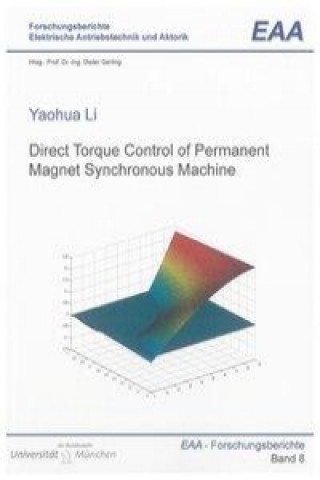
Kód: 06260375
Direct Torque Control of Permanent Magnet Synchronous Machine
Autor Yaohua Li
This thesis presents the direct torque control (DTC) for the permanent magnet synchronous machine (PMSM). The DTC has the advantages of faster torque and flux regulation, robustness to rotor parameters variation, elimination of t ... celý popis
- Jazyk:
 Angličtina
Angličtina - Vazba: Brožovaná
- Počet stran: 153
Nakladatelství: Shaker Verlag GmbH, Germany, 2010
- Více informací o knize

Mohlo by se vám také líbit
-

Dune
249 Kč -

Haunting Adeline
621 Kč -

Berserk Deluxe Volume 2
1092 Kč -

White Nights
71 Kč -

Powerless
268 Kč -

Atomic Habits
330 Kč -

Dune Messiah
228 Kč -

Berserk Deluxe Volume 3
1142 Kč -

One Day
221 Kč -

Berserk Deluxe Volume 1
1115 Kč -

Iron Flame
368 Kč -

Surrounded by Idiots
213 Kč -

Harry Potter and the Prisoner of Azkaban (Minalima Edition)
993 Kč -

Gravity Falls Journal 3
441 Kč -

Heaven Official's Blessing: Tian Guan Ci Fu (Novel) Vol. 1
430 Kč -

The Creative Act
568 Kč -

Dune
276 Kč -

Hunting Adeline
624 Kč -

A Little Life
268 Kč -

Children of Dune
230 Kč -

Heaven Official's Blessing: Tian Guan Ci Fu (Novel) Vol. 2
427 Kč
Informovat o naskladnění knihy
Zadejte do formuláře e-mailovou adresu a jakmile knihu naskladníme, zašleme vám o tom zprávu. Pohlídáme vše za vás.
Více informací o knize Direct Torque Control of Permanent Magnet Synchronous Machine
 Anotace knihy
Anotace knihy
This thesis presents the direct torque control (DTC) for the permanent magnet synchronous machine (PMSM). The DTC has the advantages of faster torque and flux regulation, robustness to rotor parameters variation, elimination of the current regulators and PWM generators. Furthermore, all the controls are carried out in the stationary reference frame, so the coordinate transformation and continuous rotor position information are not required. In the future, the DTC may become the next generation of AC motor control schemes. But the DTC for PMSM also suffers from some problems: the use of zero voltage vectors, torque ripple caused by the switching table and variable switching frequency and so on. The main aim of this thesis is to solve these problems. In this thesis, the effects of voltage vectors on the PMSM DTC drive are analyzed. New switching tables are developed. The control of the amplitude of stator flux, torque angle and torque for the PMSM DTC drive are discussed. The voltage vector selection strategy of the PMSM DTC drive is given. This thesis testified that the use of zero voltage vectors to increase the amplitude of stator flux and decrease torque can't satisfy the control of stator flux and zero voltage vectors can't be used in the PMSM DTC drive when the PMSM operates as a brake. The change of torque isn't always consistent with the change of torque angle, so the switching table can't always satisfy the control of torque and will cause torque ripple. More useful voltage vectors can be generated by the additional use of the two-phase connection to optimise the switching table in order to suppress torque ripple, but it will bring the commutation torque ripple. The angle between the voltage vector and stator flux determines the increasing or decreasing effect of the voltage vector on the amplitude of stator flux and torque angle. The control principle of torque of PMSM is proposed. Based on the voltage vector selection area for the PMSM DTC drive, the voltage vector selection strategy is developed and the space vector modulation (SVM) is used to generate the applying voltage vector. Compared with the switching table, the voltage vector selection strategy can decrease stator current and torque ripples and fix the switching frequency. All of these are verified by simulation and experimental results for a surface PMSM and an interior PMSM.
 Parametry knihy
Parametry knihy
Zařazení knihy Knihy v angličtině Technology, engineering, agriculture Energy technology & engineering Electrical engineering
- Plný název: Direct Torque Control of Permanent Magnet Synchronous Machine
- Autor: Yaohua Li
- Jazyk:
 Angličtina
Angličtina - Vazba: Brožovaná
- Počet stran: 153
- EAN: 9783832295110
- ISBN: 9783832295110
- ID: 06260375
- Nakladatelství: Shaker Verlag GmbH, Germany
- Hmotnost: 230 g
- Rozměry: 148 × 210 × 9 mm
- Datum vydání: 26. October 2010
Osobní odběr Praha, Brno a 12903 dalších
Copyright ©2008-24 nejlevnejsi-knihy.cz Všechna práva vyhrazenaSoukromíCookies



 Vrácení do měsíce
Vrácení do měsíce 571 999 099 (8-15.30h)
571 999 099 (8-15.30h)